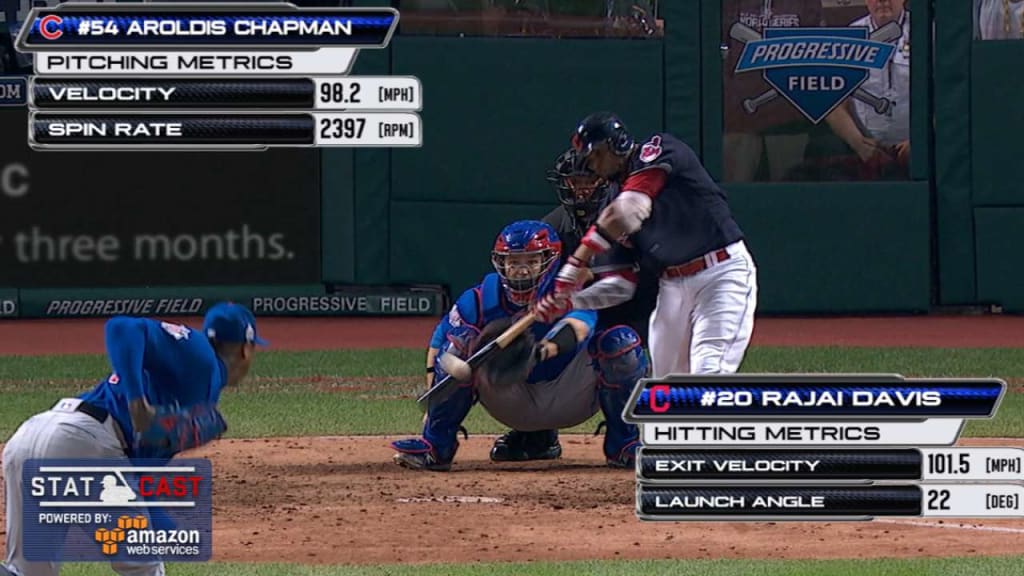Statcast of the Day: Davis takes Chapman deep to tie Game 7
This browser does not support the video element.
CLEVELAND -- It goes without saying that Game 7 of the 2016 World Series -- which ended with the Cubs snapping their 108-year title drought with an 8-7 win in 10 innings -- is going to go down as one of the most memorable games of all time. And while that's of course in large part due to the obvious history both sides entered with, let's not forget the man who played a huge part in making this game so interesting: Rajai Davis.
And thanks to Davis' game-tying eighth-inning home run off Aroldis Chapman, we didn't end up with just a good game. We ended up with a legendary one.
• Shop for Cubs World Series champs gear
:: Complete World Series coverage ::
Now, you reasonably might not have expected a well-traveled 36-year-old known more for his speed than his power to crush a homer off one of baseball's most dominant relievers. So how did he do it?
To start with, Chapman was working in his third straight game, after having thrown 62 pitches in the previous three days, including a controversial appearance protecting a five-run lead Tuesday night in Game 6. With two outs and Jose Ramirez on first base, Chapman entered to relieve Jon Lester and immediately allowed an RBI double to Brandon Guyer, making the score 6-4.
That brought up Davis, who saw seven straight fastballs, crushing the final one at 101.5 mph and 22 degrees for a 369-foot game-tying homer. But with all due respect to Davis getting the job done, it was clear the overworked Chapman wasn't the best possible version of himself. The fastball Davis hit was thrown only 98.2 mph, more than two miles below Chapman's season average of 100.9 mph.
Following the game, Cubs manager Joe Maddon noted he "felt really confident because [Chapman] felt great going into tonight," and perhaps he did.
However, in addition to the velocity being down, the spin rate was lower than usual, as well. (That makes sense, because while spin and velocity aren't necessarily related among large samples of pitchers, they usually are for individual pitchers.) Chapman's fastball came in at 2,397 rpm, which was well below his average of 2,546 rpm. What does that mean? Well, we know that high fastball spin helps the ball defy gravity for slightly longer and is positively correlated to swinging strikes and popups.
For Chapman, an average four-seam fastball has 10.7 inches of vertical movement, which is defined as being how movement above what a theoretical spin-free ball would have. On this pitch, however, it was only 8.7 inches. So while this was still an above-average fastball for most pitchers, it was 2 mph slower and 2 inches lower than the usual Chapman fastball. In terms of velocity and movement from the left side, the fastball was more similar to that of James Paxton, and while Paxton is good, his fastball whiff-per-swing percent of 16.7 percent is half of Chapman's 33.3 percent.
In addition, Davis' homer made for the highest Win Probability Added swing of the game -- that's right, even more than Ben Zobrist's 10th-inning double. WPA simply "quantifies the percent change in a team's chances of winning from one event to the next," and it does so in a way where game context is huge. That is, a single that drives in the go-ahead run in the ninth is more important than a grand slam in a 8-0 game in the third.
For Davis, his homer was a 40.5 percentage point WPA swing, meaning that Cleveland had a 12.5 percent chance of winning when it was down 6-4, and a 53 percent chance of winning as the home team in a tie game. Zobrist's game-winning hit was a change only of 32.2 percent. For context, even a famous recent Game 7 moment like Aaron Boone's 2003 home run off Tim Wakefield (36 percent) didn't change the win probability as much.
Davis and his big homer may be forgotten, because the Indians didn't win, and ultimately that's what matters. But don't forget how this game turned from good to unforgettable. It's because Chapman wasn't himself, and Davis took advantage. If things had turned out differently, they might have been building a statue of Davis outside Progressive Field.
